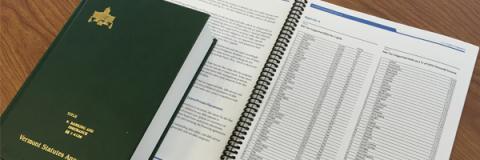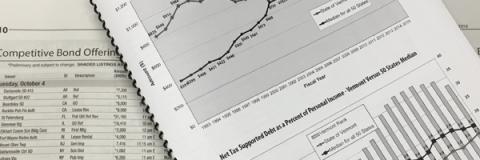Mike Pieciak is Vermont's 31st State Treasurer. He became State Treasurer in January 2023.
The State Treasurer's Office is responsible for a wide range of administrative and service duties:
- Investment of State funds.
- Issuing all State bonds authorized by the General Assembly.
- Serving as the central bank for State agencies.
- Management of the State’s cash balances, processing of checks, and the reconciliation of payroll and vendor checks.
- Safeguarding and return of unclaimed or abandoned financial property, which is held in trust by the State until the rightful owner can be located.
- Administration of three major pension plans, the deferred compensation plan, and the defined contribution plan for State employees, teachers, and participating municipalities.
The State Treasurer’s Office takes these responsibilities seriously, managing the resources within its purview effectively and efficiently and promoting prudent financial practices in the State of Vermont.
Organization
The State Treasurer’s Office is organized into an executive office and five divisions. The executive office is responsible for overall strategic planning, legislative initiatives, constituent relations, debt management, financial literacy, and supervision of the divisions. The Treasury Operations Division is responsible for the State’s banking, cash management, and financial transaction services. The Retirement Division administers three public retirement systems authorized by the legislature. Investment and Debt Management Services provides investment services for the State of Vermont and the three pension systems administered by the office, as well as debt management. The Unclaimed Property Division serves as the caretaker of abandoned or unclaimed financial property, while seeking to return it to its proper owner. Technology Services is responsible for developing and maintaining automated systems, providing appropriate access to information, maintaining the office web site, and maintaining the overall security of the office network and automated interactions with other State departments and entities outside of State government.
Treasury Operations
The Treasury Operations Division is the core operation for money movement within the State. The division is responsible for the banking, cash management, and short-term investing of State funds; the establishment and maintenance of the State’s banking network; the disbursement of the State’s warranted payments and debt service; the collection of certain receipts, including those related to education property tax payments from municipalities; and the recording of accounting transactions. Specific functions include:
- The division directs the statewide cash management activities, with annual receipts and disbursements in excess of $5 billion. Activities include oversight of the State’s cash balances, preparing cash projections, processing automated and manual checks and electronic fund transfers, and reconciling the State’s core bank accounts. The division ( in conjunction with agencies and departments, and financial institution partners) is responsible for implementing an effective and efficient statewide banking network to provide state-of-the-art cash management services and to ensure that the highest-quality services are available to customers.
- The division invests and reinvests cash balances in a manner consistent with the safety and liquidity requirements for these funds, and that maximizes the earnings on temporary funds in accordance with statute.
- The division processes approximately 1.5 million payments each year. More than two-thirds of those are conducted electronically, and one of the division's goals is to increase the proportion of transactions that occur electronically.
- The division is responsible for preparing financial statements and schedules for the annual audit of the State’s books (as it relates to cash and investment disclosures), administering the Municipal Equipment Loan Fund, and assisting the Retirement Operations Division staff in the preparation of the pension trust fund financial statements.
- This division also monitors education tax receipts from municipalities. If a municipality were delinquent in its education tax payment, the division would work to obtain proper payment. Unresolved delinquencies in payments could be referred to the Attorney General's Office for collection and/or prosecution.
Retirement Operations
The primary function of the Retirement Operations staff is to serve the needs of the active contributing members and retired members receiving benefit payments.
- The State administers three defined benefit public retirement systems authorized by the legislature. These systems provide plans for State employees, public school teachers (grades K - 12), and municipal employees. Each retirement system has a governing board of trustees, with day-to-day administration provided by the Retirement Operations Division. Approximately 45,000 people are covered by these retirement systems.
- The division provides administrative support for an optional defined contribution plan for exempt State employees. The Treasurer is the sole trustee for the fund and provides an array of investment options through a third party administrator, Fidelity Investments. The Municipal Retirement Board also provides oversight to an optional defined contribution plan.
- The Retirement Division also administers a deferred compensation (457) program, a 403(b) investment program for school districts throughout the state, and a single depository investment account (SDIA)--a tax-sheltered account funded through employee transfers to a non-contributory system for State employees and teachers.
- Services include member enrollment, provision of pension and health benefits information, retirement counseling and planning for members and retirees, collection and accounting for member and employer contributions, and financial management services for plan assets.
Investment and Debt Management Services
The Treasurer’s Office provides long-term investment services for the State of Vermont and the three pension systems. In addition, staff assists the Treasurer in the management of debt, providing central coordination for all state-issued debt. Vermont’s disciplined approach to bonding and debt management in recent years resulted in Vermont rejoining the ranks of triple-A-rated states in February of 2007.
- Certain trusts, including the Higher Education Fund, Tobacco Trust Fund, a State OPEB Trust Fund, and other trusts are pooled and invested in a Trust Investment Account (TIA). The Trustee for these funds is the State Treasurer. The Director of Investment and Debt Management assists the Treasurer in managing these assets, including asset allocation, manager selection, due diligence, and portfolio review.
- The retirement boards act as trustees for various benefit-related trusts, including the municipal defined contribution plan, SDIA fund, the 457 deferred compensation fund, and a Municipal Employees’ Health Benefit Fund. The Treasurer is also the sole trustee for a State employee defined contribution plan. All employ outside managers. The Director of Investment and Debt management and other staff provide due diligence and portfolio review, as well as contract compliance and reconciliation functions.
- The Vermont Pension Investment Committee (VPIC) acts as the trustee for the defined benefit plan investments. The State Treasurer’s Office provides administrative support including portfolio rebalancing, review, and due diligence and works with VPIC’s independent consultant to assist the VPIC members in their fiduciary responsibility. That includes development of investment policies and objectives; risk management assessment; asset allocation; investment manager searches; performance measurement; and ongoing due diligence.
- The State Treasurer’s Office is responsible for issuing and managing the State's debt in a prudent and cost effective manner, issues bonds to finance capital projects, and manages the State’s debt program. Specific responsibilities include:
- Oversee and manage the issuance of State debt.
- Manage relationships with business partners including the financial advisor, underwriters, investment bankers, and bond counsel.
- Monitor and execute refunding opportunities.
- Provide debt financing and advisory services to State agencies, authorities, boards, commissions, and higher education institutions.
- Manage and monitor arbitrage compliance, post issuance compliance, and the State’s continuing disclosure.
Unclaimed Property
The Unclaimed Property Division’s primary goal is to reunite individuals with their unclaimed financial property. Unclaimed property is cash, stocks, bonds, security deposits, and other property that is not real estate. Banks, insurance companies, and other businesses have been holding this property for the owner, but have since lost contact with the owner. State law requires that this property be turned over to the Unclaimed Property Division, which then attempts to locate the owners and return the property to them.
- The division employs a variety of programs to reach potential owners of property, including publication of an annual list of names in daily newspapers, advertising campaigns; staffing a booth at fairs and expositions; distribution of lists to town clerks and legislators; and the maintenance of a web site with search capabilities. The division promptly processes claims to return property to its rightful owners.
- Vermont’s unclaimed property statute requires entities, known as holders, to report and remit certain tangible and intangible property to the State when the owner of such property cannot be located or contacted after a certain period of time. The division takes steps to ensure that holders of unclaimed financial property file their annual unclaimed property report so that these funds can reach their rightful owners.
Technology Services
The Technology Services Division is committed to providing excellent programming and technical support services to all the divisions of the Treasurer's Office. The intent is to enhance efficiency, accuracy, and security, and to contribute to the office's commitment to a high standard of service to the State of Vermont, its clients, and its citizens. The Technology Services Division is responsible for developing and maintaining automated systems, providing appropriate access to information, maintaining the Treasurer's Office web site, maintaining the office network and its security, and providing automated interaction with other departments and entities outside State government.
Constitutional Officers
The State Treasurer is a Constitutional Officer of the Executive Branch of the State of Vermont. Constitutional officers are elected by the voters of Vermont every two years to hold state-wide offices. In addition to the Treasurer, the state-wide officers are:





